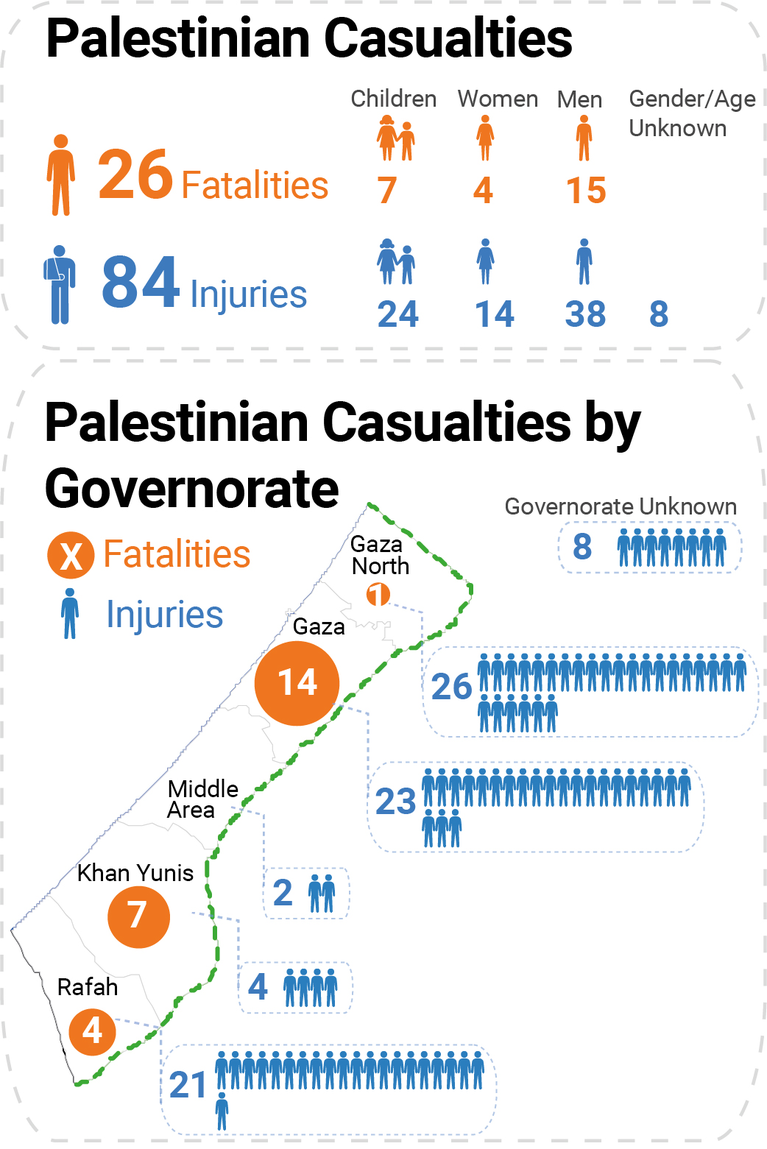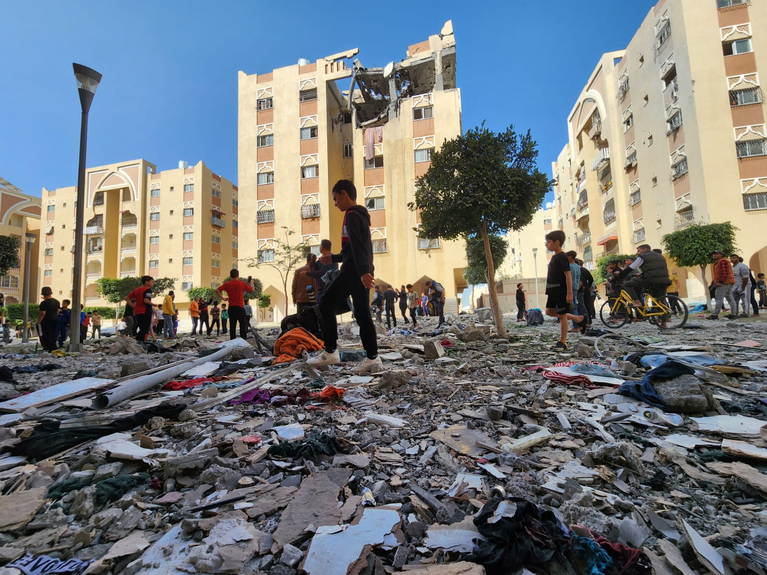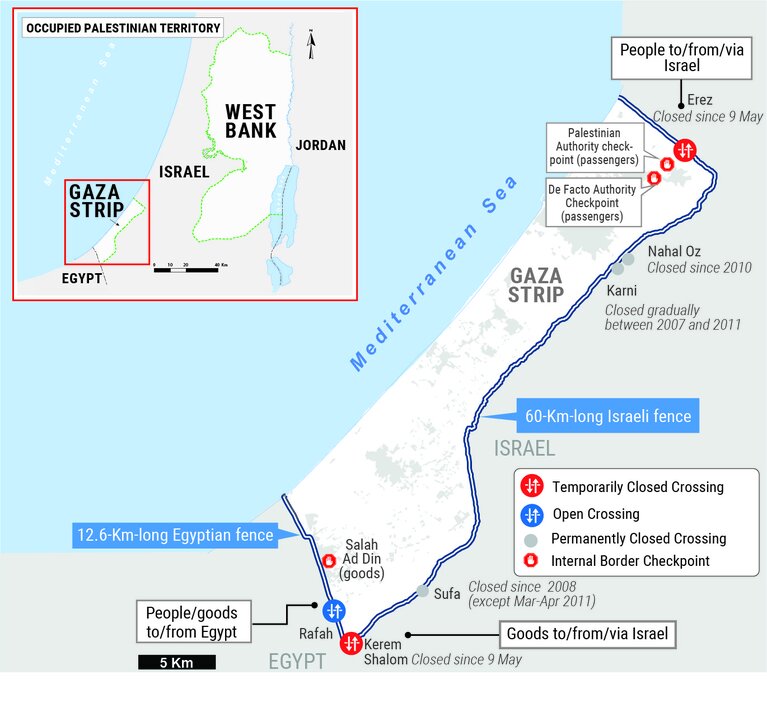Escalation of hostilities between Israeli forces and Palestinian armed groups in Gaza | Flash Update #2 as of 17:00, 11 May 2023
KEY POINTS
-
Hostilities have continued between armed groups in the Gaza Strip and Israeli forces, resulting in further casualties and damages.
-
Up to 17:00 on 11 May, the United Nations (UN) had verified 26 Palestinians fatalities, including at least 13 civilians, four members of armed groups and nine whose status is yet to be confirmed. Among the thirteen civilians were four girls, three boys, four women and two men. Up to 17:00 on 11 May, according to MoH in Gaza, 84 Palestinians have been injured, including 24 children. Of the 84 wounded, three are in critical condition, 27 are moderately injured and 46 sustained minor injuries.
-
Up to 17:00 on 11 May, Magen David Adom and hospitals in Israel reported at least 25 physical injuries, alongside people treated for shock .
-
The situation in the West Bank, including East Jerusalem continues to be tense between Palestinian communities and Israeli forces.
SITUATION OVERVIEW
On 10 May since 12:00pm, Israeli forces fired missiles toward Khan Younis and Rafah killing four Palestinian men. That same evening, another three Palestinians, including two children were killed in two explosions in the northern Gaza Strip and Gaza city.
On 11 May around 13:00, Israeli forces fired two missiles towards a residential building west of Khan Younis, reportedly targeting senior officials of the Palestinian Islamic Jihad (PIJ). Three people were reportedly killed. Several Israeli airstrikes followed across the Gaza Strip.
On 10 May and 11 May, Palestinian armed groups in Gaza continued to fire hundreds of rockets, mortar shells and other projectiles toward Israel.
Intense exchanges of fire continued throughout the afternoon and evening of 11 May.
The situation in the West Bank has also been tense:
On 11 May, one Palestinian man died of wounds sustained the previous day, in an Israeli forces’ operation that involved an exchange of fire with Palestinians in Qabatiya (Jenin), bringing the total number of fatalities in that incident to three. The Israeli military said that forces shot at Palestinians who had shot at them. Exchange of fire was also reported between Israeli forces and Palestinians, in Nur Shams refugee camp (Tulkarm), where two Palestinians were shot and injured with live ammunition fired by Israeli forces, including one who later died of his wounds.
Additional injuries and fatalities were reported in both Gaza and Israel after this reporting period and will be covered in the next report.
HUMANITARIAN OVERVIEW
- The escalation has resulted in casualties and destruction of property, worsening the humanitarian situation in Gaza. The UN Human Rights Office (OHCHR) confirmed 26 Palestinian fatalities, thirteen of whom are civilians, including seven children and four women (as of 11 May at noon). According to MoH in Gaza, 84 Palestinians have been injured, including three in critical condition.
- According to Magen David Adom and hospitals in Israel (up to 17:00 on 11 May), at least 25 people received medical treatment for physical injuries, alongside people who were treated for shock . According to the Israeli military (as of 14:30), Israeli forces have targeted 166 objectives in Gaza since the beginning of the Israeli-announced operation “Shield and Arrow” on 9 May, whereas Palestinian armed groups fired 547 rockets and projectiles towards Israel throughout the escalation, of which 394 crossed into Israel and the rest fell short and landed within Gaza or at sea.
- For the third consecutive day, both Israeli-controlled crossings, Erez (for people) and Kerem Shalom (for goods), were closed. The closure has prevented the exit and entry of hundreds of people, including patients and workers, among them aid workers. It has also prevented the entry of vital items such as food, medical supplies and fuel, at a volume of over 300 truckloads per day. Consequently, the available fuel for the operation of the Gaza Power Plant is being depleted, forcing a reduction in electricity production. As a result, the power supply has been reduced to 12-14 hours per day, seriously undermining the provision of services, including health and water, sanitation and hygiene (WASH). All gas stations are operating normally, and fuel for domestic use is available.
Protection
The Protection Cluster is closely monitoring the situation, with OHCHR and cluster partners monitoring and documenting possible violations of international humanitarian law and international human rights law, as well as civilian fatalities. The Protection Cluster has updated contingency contact lists and put key partners on alert. So far 27 protection partners have indicated that they will be active during the emergency and provide remote and in-person services in Gaza.
The United Nations Mine Action Service (UNMAS) has initiated an emergency mass-media campaign through various platforms, including social media and radio stations, to send out messages of explosive ordnance risk education (EORE) and on conflict preparedness and protection (CPP) to as many people as possible. The aim is to mitigate the risk of death and injury posed by explosive ordnance or bombing. EORE and CPP digital content have also been widely shared with Mine Action Group partners, the Protection Cluster, OCHA and other UN partners, to share via their networks and platforms. UNMAS is supporting UNRWA in assessing damage caused to two UNRWA schools.
The Gender-Based Violence (GBV) sub-cluster is conducting outreach to facilities that would be used as shelters in case of further displacement to check their emergency plans and urgent needs and to put them on alert. Most GBV response partners have activated their contingency plans and are operating hotlines. Four key GBV response partners have closed their offices, while others remain operational for medical services. GBV response partners have raised concerns about the limited number of available dignity kits (1,081), the limited access to basic emergency information (ambulances, police, and Civil Defense), the closing of service provider offices, and a lack of infrastructure to provide remote GBV protection services.
Partner hotlines have received many calls from people requesting PSS and seeking information on how to help children who suffer from fear and panic, how to evacuate women and girls with disabilities, and what the closest shelter to them is in case of evacuations. Information from hotlines suggests that many women experience depression, fear, anxiety and insecurity while continuing to provide household and childcare duties.
The Child Protection Area of Responsibility (AoR) continues to assess the impact of the situation on vulnerable groups, especially children. As with previous escalations, it anticipates that responses will be needed, including expanded, structured and specialized child protection, case management, and MHPSS aimed at supporting vulnerable children and affected families. The Ministry of Social Development (MoSD) in Gaza has activated the Child Protection networks in five governorates. These include nine counsellors who provide community support. Child Protection partners have activated remote hotline services to provide counselling and PSS. Counselling contacts have been announced, including via social media.
Shelter
According to the Ministry of Public Work and Housing in Gaza, 47 housing units sustained significant damage, including 19 that were destroyed and 28 that were severely damaged, becoming unhabitable. In addition, 286 housing units were otherwise damaged. Overall, 32 families, comprising 165 people, who had their homes destroyed or damaged since 9 May, have been internally displaced. Most are staying with host families. In addition, damage is reported to residential and commercial buildings, schools, and infrastructure such as roads, electricity networks, water installations, and farmland.
Education
All education facilities have been closed for three consecutive days, affecting over 600,000 students. All six of the Palestinian children killed during the escalation were students.
Food Security
Despite the ongoing closure of the Israeli goods crossing, there are no reports on shortages of essential items at local markets. Basic commodities are available. Bakeries and wheat flour mills are functioning normally with enough supplies.
Five ready-to-dispatch trucks carrying food supplies for the upcoming World Food Programme (WFP) in-kind distribution, set to take place in the first week of June, are on hold due to the crossing’s closure. WFP warehouses are stocked with basic commodities, including tuna fish, salt, vegetable oil, chickpeas, and lentils, that were planned to be distributed in June. The remaining stocks were expected to arrive in the upcoming period but might be delayed due to the closure. WFP is expecting a shipment of over 25 trucks carrying 900 megatons of wheat flour to Gaza. However, due to funding shortages, it risks suspending its assistance to over 200,000 people across the occupied Palestinian territory starting June.
Farmlands were damaged by hostilities in several governorates, affecting broiler and turkey farms. Farmers’ access to their lands has become dangerous. Animal fodders are still available for 10-12 days. The livestock and poultry sectors will enter a critical situation if the Israeli goods crossing remain closed. The inability to transfer goods, including agricultural produce, to the West Bank, to Israel or through Israel abroad, exacerbates the dire situation of thousands of farmers and their families. Fishing at the sea is prohibited by the local authorities, worsening the socio-economic situation of more than 4,000 fishermen affecting their only source of livelihood. Depletion of livelihood is expected if the situation continues.
Health
All health facilities are open and working, with some reduced hours and with focus on essential and emergency services, including high risk pregnancy cases. The number of patients attending maternity services, including women, has significantly reduced, raising concerns over limited access to essential health services, as people, especially women and girls, fear leaving their homes.
The Gaza MoH has activated the ‘103’ counselling line, in addition to hotlines operated by non-governmental organizations (NGOs). According to the MoH in Gaza, 292 patients and companions are unable to reach essential medical care outside the Gaza Strip.
The Health Cluster’s response in support to the MoH in Gaza has included the release of pre-positioned drugs and medical disposables worth $US200,000, the release of a trauma emergency surgical kit for the management of up to 700 cases, including 150 severe and moderate cases, and 550 minor cases, surgical kits for up to 30 cases, and drugs and medical supplies worth about $US80,000.
Prevention of sexual exploitation and abuse (PSEA) Network
The ‘121 Helpline Listening Center,’ operated by SAWA, is offering its services across the occupied Palestinian territory. It has disseminated messages among affected people to raise awareness of its services. The number of calls has not gone up. However, there is an increase in calls made by the affected population in Jenin area of the West Bank.












